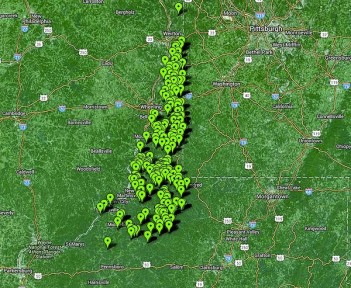
This map shows all the completed natural gas wells in West Virginia’s Northern Panhandle, totalling nearly 600. View the map and its features, which include the driller, mineral owner, surface owner and 2014 oil, natural gas and natural gas liquids production for each well, at our Shale Play website at shaleplayohiovalley.com. Click on the Well Maps tab on the header.
WHEELING, W.Va. — A single Ohio County Marcellus Shale well yielded enough natural gas in 2014 to provide electricity for 24,315 homes, according to new numbers released by the West Virginia Geological & Economic Survey.
There’s also plenty of what industry leaders term “light crude” oil being produced right here in the local region, including 45,260 barrels of oil from a well in the name of the Ohio County Commission in 2014.
Overall, with traditional vertical drilling included with horizontal fracking, West Virginia produced more than 1 trillion cubic feet of natural gas in 2014.
Drillers also extracted more than 8.3 million barrels of natural gas liquids (consisting of ethane, propane, butane, pentanes and other liquids) in 2014, according to the most recent data available from the state’s Geological & Economic Survey, an arm of the Department of Commerce.
The state also produced another 5.2 million barrels of oil.
“They are remarkable. They are shocking,” Charlie Burd, executive director of the Independent Oil and Gas Association of West Virginia, said of the numbers. “We were at about 260 billion cubic feet in 2008. Now, it just keeps going up because of fracking and horizontal drilling.”
Production, prices and pipelines
One billion cubic feet of natural gas can provide electricity to 24,315 homes for an entire year. Therefore, a single EQT Corp. well in Wetzel County provided sufficient fuel in 2014 to generate power for 77,322 homes for one year with its 3.18 Bcf. This was the most prolific well in the entire Mountain State in 2014, and serves as an easy example as to why natural gas prices are currently about $2 per Mcf.
“I remember when we got to 100 Bcf and thought that was great,” Corky Demarco, executive director of the West Virginia Oil and Natural Gas Association, said. “The thing is, we’ve probably only permitted about 5 percent of the potential Marcellus wells in West Virginia.”
According to the New York Mercantile Exchange, the price for an Mcf, or 1,000 cubic-foot unit, of natural gas late last week was about $2.25. This is down from about $6 per Mcf in early 2014.
However, industry officials said the lack of adequate pipelines in the Marcellus and Utica regions covering West Virginia, Ohio and Pennsylvania means producers are now only getting about 75 cents to $1 per Mcf.
“There is way more gas being produced than there is capacity to ship it out of the basin,” Burd said, noting the lack of adequate pipeline networks to move the material to market.
At this time, the Federal Energy Regulatory Commission continues reviewing five major pipelines, collectively valued at about $15 billion, that would allow states such as West Virginia and Ohio a chance to reach their full potential as Marcellus and Utica producers: the Atlantic Coast Pipeline, the Rover Pipeline, the Leach XPress Pipeline, the Mountain Valley Pipeline and the Nexus Pipeline.
“In these markets, it is tough. We are still seeing companies struggle. At these prices, it can’t be sustained. They are sending out so much gas and oil and liquids, but not making enough to sustain it,” added Tim Greene, owner of Land and Mineral Management of Appalachia and a former inspector for the West Virginia Department of Environmental Protection.
Well comparisons and payments
Overall, the 2014 market remained strong for both oil and natural gas. Data show the Ohio County Timmy Minch well – which includes acreage from both the Wheeling Park Commission and the city of Wheeling – produced 200 million cubic feet of natural gas and 16,956 barrels of oil. Southwestern Energy Co. took over this and other West Virginia Chesapeake Energy operations in late 2014.
A well on property in the name of the Ohio County Commission, in addition to the 45,260 barrels of oil, yielded 690 million cubic feet of gas in 2014. Another well on commission property produced 600 million cubic feet of gas and 29,006 barrels of oil, data show.
Demarco said this oil is a “light crude,” adding that drillers once found it to be more of a nuisance than an asset. Oil production in West Virginia has increased from about 27,000 barrels in 2009 to the 5.2 million barrels produced in 2014.
“We don’t have any oil pipelines in West Virginia. It is just taken out by tanker truck,” he said.
DeMarco did not have a price point at which the oil is being sold.
Greene said these depressed prices are not just a problem for drillers and frackers, but also for the mineral owners.
“Many mineral owners would rather leave it in the ground and wait until the price comes back up. But, some companies have to drill to hold leases,” Greene said. “They may have an agreement to send a specific amount of gas somewhere, which could make them keep drilling at these prices.”
Demarco and Greene said mineral owners are paid based on a number of factors, most of which are specified in one’s contract.
“If you have an 18-percent royalty, you are paid 18 percent of whatever the gas and oil sell for,” Demarco said.
For example, when natural gas was selling for $6 per Mcf, 18 percent of that is $1.08. Greene emphasized it is more complex than that, though.
“It depends on how much of your acreage is included in the well pad,” he said. “Your royalty rate applies to the acreage that you have in that pad.”
Future
Greene said mineral owners who are not getting payments now should understand the down market.
“If you’re not getting much now, just wait. It will come back,” he said. “If there is already this much production, try to imagine what there can be when we get more pipelines.”
Burd said the low prices are leading some drillers to store the gas they extract, while some are shutting down wells altogether. Still, he remains optimistic for the long-term.
“We are just scratching the surface of what we can do here,” he said.
To read more from The Intelligencer/Wheeling News-Register, subscribe here.





